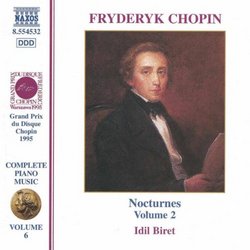| All Artists: Frederic Chopin, Idil Biret Title: Chopin: Complete Piano Music, Vol. 6 Members Wishing: 1 Total Copies: 0 Label: Naxos Original Release Date: 1/1/1999 Re-Release Date: 9/28/1999 Genre: Classical Styles: Chamber Music, Historical Periods, Classical (c.1770-1830) Number of Discs: 1 SwapaCD Credits: 1 UPC: 636943453223 |
Search - Frederic Chopin, Idil Biret :: Chopin: Complete Piano Music, Vol. 6
 | Frederic Chopin, Idil Biret Chopin: Complete Piano Music, Vol. 6 Genre: Classical
|
Larger Image |
CD Details |
CD ReviewsIdel Biret Plays the Chopin Nocturnes Robin Friedman | Washington, D.C. United States | 09/27/2006 (5 out of 5 stars) "Idel Biret is an outstanding Turkish pianist who recorded the complete works of Chopin for Naxos between 1990 -- 1992. Her playing combines great depth of feeling and romance with a subdued style and restraint -- an all-too-rare combination in the performance of Chopin. Her playing of the nocturnes, espectially her sensitive phrasing and use of rubato brought to mind the comment of Chopin's student and editor, Carl Mikuli, on Chopin's own playing. Mikuli wrote, "[I]n keeping time Chopin was inflexible, and many will be surprised to learn that the metronome never left his piano. Even in his oft-decried tempo rubato, -- one hand-- that having the accompaniment -- always played on in strict time, while the other, singing the melody, either hesitating, as if undecided, or, with increased animation, anticipating with a kind of impatient vehemence, as if in passionate utterances, maintained the freedom of musical expression from the fetters of strict regularity." Mikuli aptly described how Biret would perform the nocturnes with their steady, repeating left hand figurations and flights of long melody and exquisite runs and ornamentation in the right hand.
Biret recorded the Chopin nocturnes in two volumes. This, the second volume, includes both Chopin's earliest nocturne with an opus number, the nocturne in E minor, opus 72 no. 1, composed when the composer was 17, and his final efforts in the form, the two nocturnes of opus 62, dating from 1846. Biret's first volume of the nocturnes includes the ten works from opus 9 through opus 32, dating from 1836-37, in addition to two early works without an opus number. This volume, following opus 72, picks up with the two nocturnes of opus 37, composed in 1838, and proceeds with the two works of opus 48, the two nocturnes of opus 55, and the final two nocturnes of opus 62. Thie nocturnes are romantic, lyrical, and pensive with song-like lengthy melodic lines. There is a great deal of variety and beautiful music in the nocturnes in this volume. The early nocturne opus 72 no. 1 is simpler in style than most of its successors. It features a flowing melody, less ornamented than most of the nocturnes, played over triplets and an intense middle section. The nocturne in G minor opus 37 no. 1 is special to me because it is one of the few Chopin nocturnes I have attempted myself. (Another is opus 55 no. 1.) It is simple and melancholy in structure, with an accompaniment consisting of four quarter-notes, and a chordal, solemn middle section. Its companion in G major, opus 37 no.2 features a long, piquant melody consisting of running figures in thirds and sixths, which Idel Biret plays lyrically, smoothly and convincingly. The nocturne in C minor opus 48 no. 1 is Chopin's largest effort in the form. It opens with a quiet, stately theme, which Chopin develops inexorably into a section of large deep rolled chords ahd hammering, extensive passages in octaves for both hands before the nocturne works to a quiet close. The companion-piece in F-sharp minor is, in contrast, peaceful and tranquil in mood. The nocturne in E minor, opus 55 no. 1 is frequently performed with a haunting theme over a simple accompaniment figure and a passionate, lively coda. Its companion-piece in E-flat major includes a richly-textured melody combined with much ornamentation over repeated accompaniment figures in triplets. Chopin's final two nocturnes, opus 62, are frequently regarded as differing from the other works in the series in their spare and deeply introspective, almost mystical, character. (By chance, these were among the first Chopin nocturnes I heard when young.) Opus 62 no. 1 opens with some deep, pensive slow arpeggios, and features long, light runs and highly elaborate trills as the work progresses. The final nocturne, in E major opus 62 no.2, is highly melodic, with an elaborate and agitated central section. Although Idel Biret's performances of Chopin have received wide-spread critical acclaim, the nocturnes have been extensively recorded by many well-known artists. Thus Biret's readings still await their deserved wide discovery and appreciation. This recording and its companion will serve as an outstanding introduction to Chopin's nocturnes. Robin Friedman" |

 Track Listings (9) - Disc #1
Track Listings (9) - Disc #1